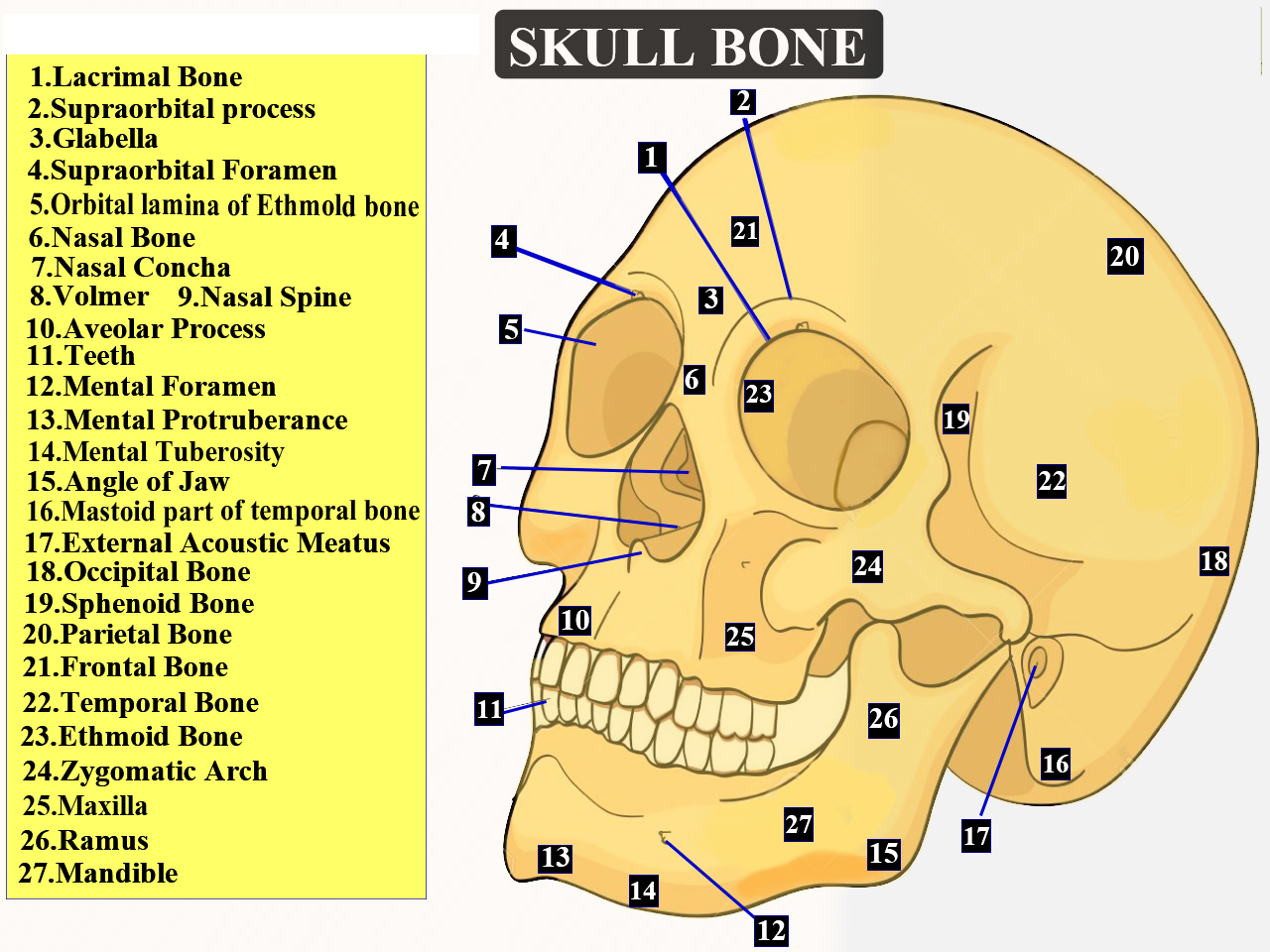
Total number of bones found in the human skull is
(A) 22
(B) 29
(C) 35
(D) 72
Answer
492k+ views
Hint: Skull consists of different types of bones. Specifically, it has four different types of bones which are Cranial bones (eight in number), Facial bones (fourteen in number), a single hyoid bone, and ear ossicles (six in number) .
Complete step by step answer:
The total number of bones found in the human skull is 29. The eight cranial bones are the frontal, 2 parietal, occipital, 2 temporal, sphenoid, and ethmoid bones.
The 14 facial bones are the two maxilla, mandible, 2 zygomas, 2 lacrimal, 2 nasal, 2 turbinate, vomer, and a couple of palate bones. The hyoid is a horseshoe-shaped bone at the bottom of the tongue.
The six auditory ossicles (little bones) are the malleus, incus, and stapes in each ear.

So, the correct answer is ‘29’.
Additional Information: The human brain is the central organ of the human nervous system, and the addition of the spinal cord makes up the central nervous system. The brain consists of the cerebrum, the brainstem, and also the cerebellum. It controls most of the activities of the body, processing, integrating, and coordinating the data it receives from the sense organs and making decisions as the instructions
sent to the remainder of the body. The brain is contained in, and guarded by, the skull bones of the head. The cerebrum is the largest part of the human brain and the smallest part is the Habenular Nuclei.
Note: The skull of fishes is made from a series of only loosely connected bones. Only a few fishes like lampreys and sharks only possess cartilaginous endocranium, with both the upper and lower jaws being separate elements. In bony fishes, they have additional dermal bone, forming a more or less coherent skull roof in lungfish. The lower jawbone defines a chin.
Complete step by step answer:
The total number of bones found in the human skull is 29. The eight cranial bones are the frontal, 2 parietal, occipital, 2 temporal, sphenoid, and ethmoid bones.
The 14 facial bones are the two maxilla, mandible, 2 zygomas, 2 lacrimal, 2 nasal, 2 turbinate, vomer, and a couple of palate bones. The hyoid is a horseshoe-shaped bone at the bottom of the tongue.
The six auditory ossicles (little bones) are the malleus, incus, and stapes in each ear.

So, the correct answer is ‘29’.
Additional Information: The human brain is the central organ of the human nervous system, and the addition of the spinal cord makes up the central nervous system. The brain consists of the cerebrum, the brainstem, and also the cerebellum. It controls most of the activities of the body, processing, integrating, and coordinating the data it receives from the sense organs and making decisions as the instructions
sent to the remainder of the body. The brain is contained in, and guarded by, the skull bones of the head. The cerebrum is the largest part of the human brain and the smallest part is the Habenular Nuclei.
Note: The skull of fishes is made from a series of only loosely connected bones. Only a few fishes like lampreys and sharks only possess cartilaginous endocranium, with both the upper and lower jaws being separate elements. In bony fishes, they have additional dermal bone, forming a more or less coherent skull roof in lungfish. The lower jawbone defines a chin.
Recently Updated Pages
Master Class 11 Economics: Engaging Questions & Answers for Success

Master Class 11 Business Studies: Engaging Questions & Answers for Success

Master Class 11 Accountancy: Engaging Questions & Answers for Success

Master Class 11 English: Engaging Questions & Answers for Success

Master Class 11 Computer Science: Engaging Questions & Answers for Success

Master Class 11 Maths: Engaging Questions & Answers for Success

Trending doubts
State and prove Bernoullis theorem class 11 physics CBSE

1 ton equals to A 100 kg B 1000 kg C 10 kg D 10000 class 11 physics CBSE

State the laws of reflection of light

One Metric ton is equal to kg A 10000 B 1000 C 100 class 11 physics CBSE

1 Quintal is equal to a 110 kg b 10 kg c 100kg d 1000 class 11 physics CBSE

Difference Between Prokaryotic Cells and Eukaryotic Cells




